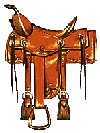
Article
-
Rules of Thumb for Saddle Fit
In compiling information on achieving a proper fit to the horse when purchasing a saddle I came up with several "Rules of Thumb" to bear in mind.
There's a wealth of information available on the subject of saddle fitting, some of it contradictory. It's easy for the first time (or even second time) saddle buyer to get confused . The following Rules of Thumb are designed to help a prospective buyer get pointed in the right direction.
The Rules
Rule of Thumb #1: All saddles don't fit all horses.
This would seem obvious, but the novice might buy a saddle with only the rider in mind. While it's obvious that a Belgian, Quarterhorse, and Haflinger would each require a saddle of a different size this is still a good rule to keep in mind.
Rule of Thumb #2: Some western saddle (trees) fit most western or stock horses.
There is truth to this statement. A Western Saddle built on semi-quarter horse bars will fit most cow ponies and similarly an English saddle on a medium tree will fit most horses. Either way, you have maybe an 80% chance of success. But if you have to go through the hassle of returning a saddle or have to suffer with a poor fit those aren't necessarily the best odds.
Rule of Thumb #3: If you purchase a saddle based on appearance alone, it won't fit (Murphy's Law applied to saddle buying).
Well, we all do things like this occasionally, probably more with automobiles than with saddles. It's hard to turn down something that appeals to the eye. But most experienced horsemen and horsewomen wouldn't buy based on looks alone - would we?
Rule of Thumb #4: Like other things in life, the more information you gather, the better your chance of success.
What this says is that if you're going to purchase a saddle, the more you know about saddles and the more you know about the horse(s) in question, the better your chance of success (a good fit) will be. You needn't be an expert - just take the time to learn a few things like, why fit is important, the basic parts of the saddle tree, etc..
A corollary to this rule is - find out what the saddle maker or retailer needs in the way of information to get you the saddle you need. If they don't ask for some information find another retailer.
Rule of Thumb #5: If you don't know a lot about horses, get someone who does to help you out.
Put another way - If you don't know what you're doing, don't do too much of it. This is probably the best ruile for the novice to follow. Get a friend or aquaintance who knows a lot about horses, or your vet or your local outfitter - anyone you feel you can trust - to help you out. They can tell you what measurements to need to take or, by looking at the horse, whether you really need to take any. Getting some expert assistance can save you lots of grief downstream.
Rule of Thumb #6 (Golden Rule): You won't know for sure if the saddle fits until you put it on the horse and go for a ride.
This rule has all sorts of implications. "Measuring" the horse for saddle fit can range from visual inspection to withers tracings to molds and high tech measuring devices. The more you measure the better the fit you are apt to achieve but at some point it can be overkill because you never achieve a "perfect fit". The only way to validate good fit is to put the saddle on the horse and go for a ride.
Copyright © 2005 W. Savage. All Rights Reserved.
William "Bill" Savage, a retired, engineer lives on the Goose Bay Ranch in Montana where he spends time with family, horses, and his web site -
www.your-guide-to-gifts-for-horse-lovers.com
**********
Back to Your Guide to Gifts for Horse Lovers Home Page